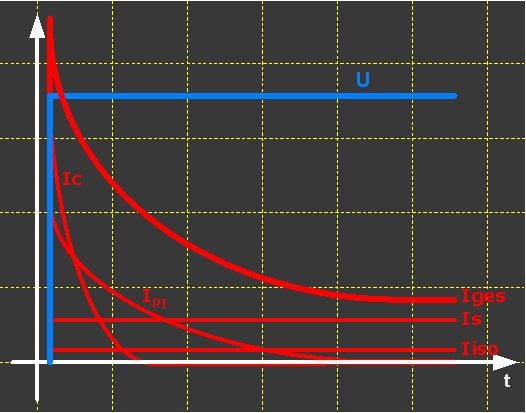Know How
Insulation Resistance
The insulation resistance test takes place with complex theoretical view at a replacing display, consisting of 4 basic components.
These are:
-
C = capacitor between both poles
-
Rs = surface resistance
-
Rpi+Cpi = equivalent of the polarization index
-
Riso = insulation resistance
Why?
The test object has an insulation resistance between two test points. This is the resistance Riso. This resistance is usually quite high and is between some 100M§Ù up to 10T§Ù.
In addition the test object also has a capacity between both test points. This is either formed between the windings to be tested or from the windings to the body. Between the windings it is usually lower than from the winding to the body. Capacities occur between uninsulated metal surfaces. The bigger the surface or the lesser the distance of the metal surfaces towards each other the bigger is the capacity. With in the stator the windings form one metal surface and the sheet packets the other. The bigger the stator (size) the bigger become the surfaces and thus the capacity.
An electric product often has bare uninsulated electrical leads. This is for example valid for a DC motor. At the surface of the leads electrically conducting dust may be deposited and/or humidity condensed. This results in a kind of surface resistance. In the ideal case this should be unlimited but sometimes it can become extremely low (< 1M§Ù).
Electrical insulating material like for example resin and so on have dipole similar molecules. Thus they show a +/- polarization. When connecting a high-voltage DC all molecules adjust to the electrical field. Only after the end of a time this polarization is finished. this should be simulated by the RC element.
Which currents arise from this?
After having connected the test voltage a total current (Iges) arises which consists of 4 single currents.
Total current = Iges = Ic + Is + Ipi + Iiso
Via the ohmic law the total insulation resistance is calculated.
This is: Rgiso = Uhv/Iges
Due to the fact that both currents Ic and Ipi become zero after a time this time has to be waited for for a detailed evaluation of the insulation resistance.

The charging of the capacitor is done fast and finished after a few seconds in most of the cases. This aim is to charge the capacitor within max. 30 seconds. After this time ic is 0:
The charging of the polarization capacity takes considerably more time. In the worst case this could take up to 10 minutes at an electric motor. Among such conditions it thus could take more than 10 minutes until the real insulation can be detected.
Request detailed information - The SCHLEICH test methods Fibel
Fields with * are mandatory.
Data Privacy Statement
Data Protection
The operators of this website take the protection of your personal data very seriously. We treat your personal data confidentially and according to the legal data protection regulations and this Privacy Policy.
The use of our website is usually possible without providing personal data. Personal data, such as names, addresses or e-mail addresses, are always provided on a voluntary basis if possible. Those data will not be passed on to third parties without your explicit permission.
However, we would like to point out that data transmissions via internet (e.g. e-mail communication) cannot be entirely secure and may have security vulnerabilities. A complete protection of personal details against unauthorised access by third parties is not possible.
Cookies
This website partially uses so-called cookies. Cookies do not cause damages to your computer and do not contain viruses. Cookies allow us to make our offer more user-friendly, more efficient and more secure. Cookies are small text files, stored by your browser on your computer.
The most cookies that we use are so-called “session cookies”. They will be deleted automatically after the end of your visit. Other cookies remain on your terminal device. Those cookies enable us to recognise your browser on your next visit.
You can adjust your browser that way in order to be informed when cookies are placed, to individually allow cookies or to generally exclude cookies in certain cases as well as to activate the automatic deletion of cookies when closing the browser. The deactivation of cookies may impair the functionality of this website.
Server-log-files
The provider of these websites automatically collects and stores information in so-called server log files which your browser automatically transmits to us, such as
- browser type/version
- used operating system
- referrer URL
- host name of the accessing computer
- time of query
Those data cannot be associated with individual persons. A merging with other data sources does not take place. We reserve the right to retrospectively check the data if reasonable evidences concerning illegal use become known.
Contact form
If you send enquiries to us via the contact form, your data entered into the contact form, including the stated contact data, are stored for the purpose of dealing with your enquiry and in case of additional enquiries. Those data will not be passed on without your permission.
Newsletter
If you would like to receive the newsletter offered on our website, we require your email address as well as information which allow us to check that you are the owner of the provided email address and that you agree to the reception of the newsletter. Further data will not be collected. We use those data exclusively for the sending of the requested information and do not transmit them to third parties.
The given permission to the storage of the data, the email address as well as the use of such for the purpose of sending the newsletter can be withdrawn at any time via the "Unsubscribe"-link within the newsletter.
Privacy Policy for the use of Google Analytics
This website uses Google Analytics, a website analysis service by Google Inc., 1600 Amphitheatre Parkway Mountain View, CA 94043, USA.
Google Analytics uses so-called "cookies", text files that are stored on your computer to analyse your use of the website. The information generated by the cookie about your use of this website is usually sent to and stored at a Google server in the U.S.A.
You find more information concerning the treatment of user data by Google Analytics in Google's Privacy Policy: https://support.google.com/analytics/answer/6004245?hl=de
Browser Plugin
You may prevent the installation of cookies by adjusting the settings of your browser; however, if you do so, you may be unable to use all features of this website. Further, you may prevent the collection of data generated by cookies (including your IP address) and related to the use of this websites as well as the processing of such data by Google by downloading and installing the plug-in under the following link: http://tools.google.com/dlpage/gaoptout?hl=en
Objection to Data Collection
You may prevent the collection of data by Google Analytics by clicking the following link. Doing so, an Opt-Out-Cookie will be placed which prevents future data collection when visiting our website: Disable Google Analytics
IP-anonymisation
We us the function "Activate IP-Anonymisation". Through this, your IP-address will be shortened priory within the member states of the European Union or other contractual states of the Treaty on the European Economic Area. Only in exceptional cases your complete IP-address will be transmitted to a server in the U.S.A. and shortened there. Commissioned by the operators of this website, Google will use this information to evaluate your use of the website, to compile reports on website activities for website operators and to provide other services related to website and internet activities. Google will not merged your IP address with any other data held by Google.
Privacy Policy for the use of Google Web Fonts
For the homogenous display of fonts, this website uses so-called web fonts that are provided by Google. On retrieving a website your browser downloads the necessary web fonts to your browser cache in order to correctly display texts and fonts. If your browser does not support web fonts, your computer uses a standard font.
For further information, please see https://developers.google.com/fonts/faq as well as Google's Privacy Policy: https://www.google.com/policies/privacy/
Privacy Policy for the use of Google Maps
This website uses the map service Google Maps via API. This service is provided by Google Inc., 1600 Amphitheatre Parkway Mountain View, CA 94043, USA. To use the functions of Google Maps it is required to store your IP address. This information will usually be transferred to and stored on a server in the USA. The provider of this website has no influence on this data transmission.
For further information, please see Google's Privacy Policy: https://www.google.de/intl/de/policies/privacy/
Right to Information, Deletion, Blocking
You have the right to be informed about your person-related data, their origin and addressee and the purpose of data processing as well as the right to correction, blocking or deletion of those data at any time and free of charge. For further questions and questions concerning person-related data, feel free to contact us under the address published in the impressum/legal notice.
Objection to commercial mails
Providers are obligated to publish contact information in the Legal Note/Impressum. The use of such contact information by third parties for the purpose of distributing unsolicited advertisements or other commercial information is prohibited. The operators of this website reserve the right to take legal measures in case of being sent unsolicited commercial information, e.g. spam mails etc.
